Preparation of Transdermal Patch Containing Selenium Nanoparticles Loaded with Doxycycline and Evaluation of Skin Wound Healing in a Rat Model
- PMID: 36355552
- PMCID: PMC9697751
- DOI: 10.3390/ph15111381
Preparation of Transdermal Patch Containing Selenium Nanoparticles Loaded with Doxycycline and Evaluation of Skin Wound Healing in a Rat Model
Abstract
The present study aimed to prepare and evaluate a controlled-release system based on a chitosan scaffold containing selenium nanoparticles loaded with doxycycline. Its topical application in skin wound healing in rats was investigated. Therefore, 80 female rats were used and, after creating experimental skin defects on their back, were randomly divided into four equal groups: the control group without any therapeutic intervention; the second group received a chitosan transdermal patch (Ch); the third group received chitosan transdermal patch loaded with selenium nanoparticles (ChSeN), and the last group received chitosan transdermal patch containing selenium nanoparticle loaded by doxycycline (ChSeND). Morphological and structural characteristics of the synthesized patches were evaluated, and in addition to measuring the skin wound area on days 3, 7, and 21, a histopathological examination was performed. On the third day of the study, less hemorrhage and inflammation and more neo-vascularization were seen in the ChSeND group. Moreover, on day 7, less inflammation and collagen formation were recorded in the ChSeN and ChSeND groups than in the other groups. At the same time, more neo-vascularization and re-epithelialization were seen in the ChSeND group on days 7 and 21. In addition, on day 21 of the study, the most collagen formation was in this group. Examination of the wound area also showed that the lowest area belonged to the ChSeND group. The results showed that the simultaneous presence of selenium nanoparticles and doxycycline in the ChSeND group provided the best repair compared to the control, Ch and ChSeN groups.
Keywords: chitosan; doxycycline; rat; selenium nanoparticle; skin wound healing.
Conflict of interest statement
The authors declare no conflict of interest.
Figures
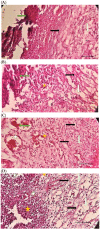

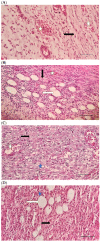
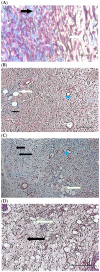
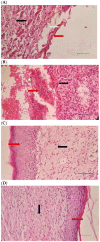
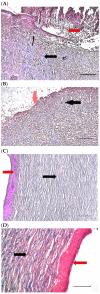






Similar articles
-
Histopathologic evaluation of skin wound healing due to local application of transdermal chitosan patch in combination with doxycycline, zinc nanoparticles, and selenium nanoparticles in mice.BMC Vet Res. 2025 Mar 31;21(1):221. doi: 10.1186/s12917-025-04672-5. BMC Vet Res. 2025. PMID: 40159480 Free PMC article.
-
Preparation and evaluation of chitosan skin patches containing mesoporous silica nanoparticles loaded by doxycycline on skin wound healing.Arch Dermatol Res. 2023 Jul;315(5):1333-1345. doi: 10.1007/s00403-022-02518-w. Epub 2022 Dec 28. Arch Dermatol Res. 2023. PMID: 36576582
-
Topical delivery of chitosan-capped silver nanoparticles speeds up healing in burn wounds: A preclinical study.Carbohydr Polym. 2018 Nov 15;200:82-92. doi: 10.1016/j.carbpol.2018.07.077. Epub 2018 Jul 26. Carbohydr Polym. 2018. PMID: 30177212
-
Histopathological Evaluation of Spinal Cord with Experimental Traumatic Injury Following Implantation of a Controlled Released Drug Delivery System of Chitosan Hydrogel Loaded with Selenium Nanoparticle.Biol Trace Elem Res. 2021 Jul;199(7):2677-2686. doi: 10.1007/s12011-020-02395-2. Epub 2020 Sep 22. Biol Trace Elem Res. 2021. PMID: 32959339
-
Design, fabrication, and evaluation of keratin and pectin incorporated supramolecular structured zero-oxidation state selenium nanogel blended 3D printed transdermal patch.Int J Biol Macromol. 2024 May;268(Pt 1):131769. doi: 10.1016/j.ijbiomac.2024.131769. Epub 2024 Apr 30. Int J Biol Macromol. 2024. PMID: 38692999
Cited by
-
Advancements in employing two-dimensional nanomaterials for enhancing skin wound healing: a review of current practice.J Nanobiotechnology. 2024 Aug 30;22(1):520. doi: 10.1186/s12951-024-02803-y. J Nanobiotechnology. 2024. PMID: 39210430 Free PMC article. Review.
-
Selenium Compounds Affect Differently the Cytoplasmic Thiol/Disulfide State in Dermic Fibroblasts and Improve Cell Migration by Interacting with the Extracellular Matrix.Antioxidants (Basel). 2024 Jan 26;13(2):159. doi: 10.3390/antiox13020159. Antioxidants (Basel). 2024. PMID: 38397757 Free PMC article.
-
Histopathologic evaluation of skin wound healing due to local application of transdermal chitosan patch in combination with doxycycline, zinc nanoparticles, and selenium nanoparticles in mice.BMC Vet Res. 2025 Mar 31;21(1):221. doi: 10.1186/s12917-025-04672-5. BMC Vet Res. 2025. PMID: 40159480 Free PMC article.
References
-
- Saghazadeh S., Rinoldi C., Schot M., Kashaf S.S., Sharifi F., Jalilian E., Nuutila K., Giatsidis G., Mostafalua P., Derakhshandeh H., et al. Drug delivery systems and materials for wound healing applications. Adv. Drug Deliv. Rev. 2018;127:138–166. doi: 10.1016/j.addr.2018.04.008. - DOI - PMC - PubMed
-
- Dutta P., Tripathi S., Mehrotra G., Dutta J. Perspectives for chitosan based antimicrobial films in food applications. Food Chem. 2009;114:1173–1182. doi: 10.1016/j.foodchem.2008.11.047. - DOI
-
- Cerdá C., Sánchez C. Climent, B.; Vázquez, A.; Iradi, A.; Amrani, F.E.; Bediaga, A.; Sáez, G.T. Oxidative stress and DNA damage in obesity-related tumorigenesis. Adv. Exp. Med. Biol. 2014:5–17. - PubMed
LinkOut - more resources
Full Text Sources

